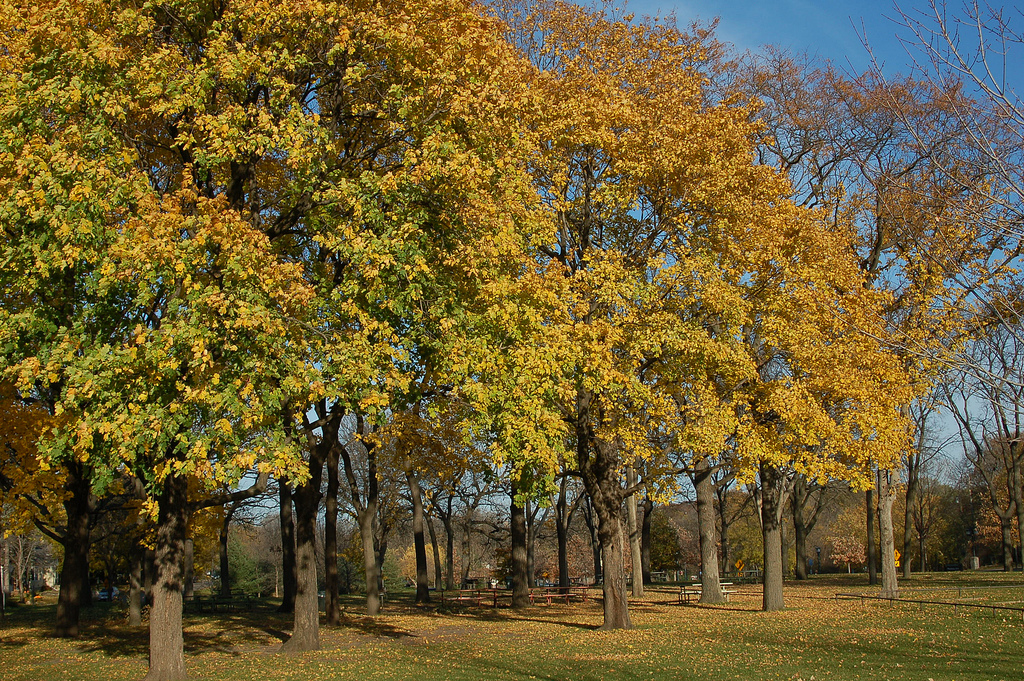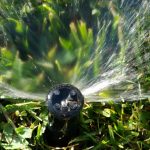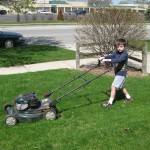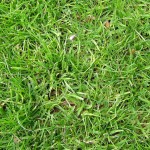
Don’t abandon lawn care during the fall!
Fall is the best time of the year to fertilize your lawn and control weeds. Plus, if you put a little bit of work in during the fall then when spring rolls around you’ll be pleasantly surprised with a green, healthy lawn. Preparing for the upcoming season is mostly research and planning – the work is pretty easy.
1. Mowing Your Lawn
Photo: Flickr / Bob Henry Photography
Either check out our Minneapolis grass types guide, or simply keep your grass 2 to 2 ½ inches tall throughout the fall. If your grass gets much longer—more than 3 inches—it will mat, leading to winter lawn disease problems such as snow mold and other types of fungus.
Comparatively, if you mow it shorter than 2 inches, you’ll severely limit its ability to make and store food for growth in the spring.
Lastly, keep your mower blades sharpened to produce a clean, healthy cut. Dull blades tear the grass and is an open invite to lawn disease.
2. Raking Leaves
Leaving an excess of leaves and organic debris piled on top of your grass is terrible for the lawn’s overall health. If left piled on top of the lawn for too long the build up of debris can actually suffocate the grass, restricting the necessary amount of water, sunlight, and nutrients.
Also, be sure to blow grass clippings off all hard surfaces such as driveways, sidewalks, and streets to avoid runoff and pollution—just to be eco-friendly. Plus it just makes your lawn look that much more neat!
3. Recycling Leaves
Photo: Flickr / drea
A popular way that homeowners like to recycle leaves is by creating a compost pile. Over the time the compost pile breaks down and condenses itself into a natural fertilizer. Always pull from the bottom and make sure to blend the pile after use. It works great as a natural source of nitrogen for your flower beds.
If you commit to mowing regularly during the fall, another viable option is using a mulch mower to chop the leaves into tiny pieces and spit them back into the lawn. Once again making a great source of natural nitrogen fertilizer for your lawn. AND you get to skip the dreaded leaf cleanup at the end of the season.
4. Watering Your Lawn
Watering your lawn should still play a key role in your lawn care plan, even as the temperatures drop. Grass still needs water to grow, especially because cool-season grass types have higher growth rates than the spring. Keep watering your lawn until the first frost. Check out our Minneapolis lawn watering post for more details.
5. Fertilizing Your Lawn
Fertilizing your lawn properly will also protect your grass through winter. You should apply the final round of fertilization in your lawn in mid-October. When you choose your fertilizer, you may be drawn toward types that have large amounts of phosphorus.
However, you might not need that much phosphorus. Test your soil to find out what nutrients are lacking—this will ensure you provide the right amount of phosphorus, potassium, and nitrogen your grass needs while in hibernation mode.
Contact your local extension office for a soil test.
6. Broadleaf Weed Control
Photo: Flickr / Simon
Fall is a good time to control perennial broadleaf weeds such as dandelions, plantain (shown in photo above), clover, and creeping charlie. Only a few weeds can be removed by hand. If your weeds are far and few between—or confined to just a few small areas—spot-treating them with herbicide is usually the way to go. Weed-control products sold in ready-to-use spray containers make spot treatment easy. Be sure to complete treatments while temperatures are above 50°—your herbicide needs time to do its job before winter cold sets in.
Don’t settle on a weed-control strategy without careful consideration of the number and types of weeds in your lawn. Remember—you don’t need to apply herbicides over your entire lawn unless you’re dealing with a weed infestation. And don’t worry about controlling crabgrass—that battle was lost back in spring. The first hard frost will kill annual weeds.
7. Seeding and Sodding Your Lawn
Fall is the best time of year to establish or repair lawns by seeding or sodding In Minneapolis, cool-season species of grass are the most practical choices. Kentucky bluegrass, perennial ryegrass, fine fescues, and tall fescues are tried and true options in the upper Midwest. However, you shouldn’t seed and sod after mid-September – it’s just too cold.
Pro tip: If you plan on reseeding or overseeding your lawn, avoid using pre-emergents. Not only will this prevent the weeds from sprouting but will also deter the new seed from germinating.
Have questions about lawn care? Visit our Minneapolis lawn care page or share your thoughts in the comments section below.








